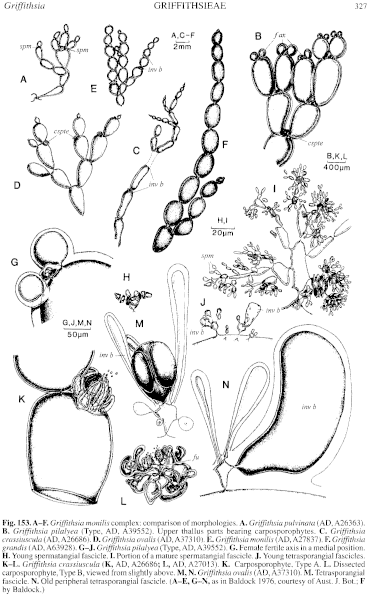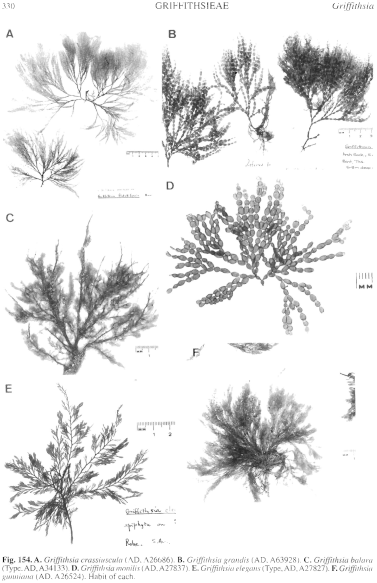|
|
|
|
|
|||||||||||
|
Electronic Flora of South Australia Species Fact Sheet
Phylum Rhodophyta – Order Ceramiales – Family Ceramiaceae – Tribe Griffithsieae
Selected citations: J. Agardh 1851: 79. Allender 1981: 22. Baldock 1976: 526, figs 11–13, 77. De Toni 1903: 1283. Lucas 1909: 48. Silva et al. 1996: 411.
Synonyms
Griffithsia flabelliformis Harvey 1844: 450. De Toni 1903: 1278. De Toni & Forti 1923: 51. Guiler 1952: 95. Lucas 1909: 48; 1929a: 24; 1929b: 52. Lucas & Perrin 1947: 326. Sonder 1853: 675. Srinivasan 1973: 5, pl. V. Womersley 1950: 177.
Griffithsia corallina C. Agardh var. tasmanica Kützing 1849: 659.
Griffithsia corallina sensu Harvey 1859b: 332. Sonder 1855: 514; 1881: 11. Tisdall 1898: 502.
Griffithsia tasmanica (Kützing) Kützing 1862: 7, pl. 19 figs c–e. J. Agardh 1876: 64; 1879: pl. 1, fig. 14. Askenasy 1888: 36, pl. 9, figs 2, 3. Grunow 1868: 62. Hemsley 1884: 281. Reichardt 1871:23. Sonder 1881: 11. Tisdall 1898; 502. Wilson 1892: 186.
Thallus (Fig. 154A) light red, spreading, 9–26 cm high, subdichotomous many times, ecorticate, filaments constricted between cells and apically attenuate. Attached by rhizoids from basal cells; epilithic. Structure. Cells (Fig. 153C) in upper thallus globose-ovoid, 1–1.5 mm in diameter and L/D 1.9–2.2; in mid thallus allantoid, or cylindrical with swollen ends (bone-shaped), 1.4–2.2 mm in diameter and L/D 1.7–3; basal cells cylindrical, 0.6–1.6 mm in diameter and L/D 2.8–4.
Reproduction: Gametophytes dioecious. Female axes 3-celled, associated with whorls of 12–17 polychotomous, hair-like, synchronic laterals, displaced laterally by continued growth of the vegetative apical cell. Procarp systems subapical, each with a sterile lateral cell and a supporting cell with an apical sterile cell and lateral 4-celled, recurved carpogonial branch; the inner of two post-fertilisation connecting cells fusing with the supporting cell which cuts off an auxiliary cell; post-fertilisation fusion cell columnar (Fig. 153L), bearing 1–3 gonimolobes terminally, most cells of which produce ovoid-clavate carposporangia, 35–55 µm in diameter. Carposporophytes lateral in the constrictions between cells (Fig. 153K).
Two carposporophyte types exist, separated on their involucral branches.
Type: Type A produces 7–10 involucral branches in which the larger terminal cells are 320–450 µm long, regular and incurved (Fig. 153K).
Type B produces 5–6 involucral branches with terminal cells 540–850 µm long, furcate or distinctly irregularly lobed (Fig. 153L).
Type from "Ad Novam Hollandiam"; in PC.
Selected specimens: Point Lowly, Spencer Gulf, S. Aust., 22–24m deep (Womersley, 22.vii.1971; AD, A39285). American R. inlet, Kangaroo I., S. Aust., 2–4m deep (Baldock, 22.viii.l963; AD, A26686 and A27013). Saunders Beach, Eastern Cove, Kangaroo I., S.Aust., drift (Womersley, 21.xi.1968; AD, A32896). San Remo, Western Port, Vic., drift (Sinkora A539, 14.vi.1970; AD, A62649). Gordon, Tasmania, 6 m deep (Womersley, 20.x.1949; AD, A12596). Great Taylor Bay, Bruny 1., Tasmania, 2–5 m deep (Baldock, 14.ii.1972; AD, A41311).
Distribution: Swan River, W. Aust. to Tasmania. India and St Paul Island, Indian Ocean.
Taxonomic notes: Hair-like synchronic laterals are successively produced and shed so that carposporophytes may be surrounded by several whorls in various stages of development. Spermatangia borne on numerous minute fascicles from the upper shoulders of usually only subapical vegetative cells, clustered in the constriction between cells. Initially a synchronic whorl of 6–8 fascicles resembling the initials of hair-like synchronic laterals develops, but this is soon followed by the production of numerous other fascicles, each consisting of an ovoid basal cell 10–20 µm in diameter bearing 5 branches dividing polychotomously 4–6 times, in which the terminal cells produce 1–2 spermatangia; involucral cells absent.
Tetrasporangia occur on numerous whorls of minute fascicles clustered in constrictions of cells near the thallus apex (Fig. 153C), inner fascicles consisting of short pedicels 40–50 µm long bearing a whorl of 3–7 lachrimiform tetrasporangia 55–67 µm in diameter, produced successively, and tetrahedrally divided; outermost fascicles also each bearing 1 (–2) inflated, incurved 1-celled involucral branches, 110–180 µm in diameter and L/D 1.5–2, forming a composite palisade-like involucre about clusters.
A species of large plants with allantoid cells, related to the G. monilis Group reproductively, growing in estuarine conditions, 2–5 (–22) m deep, commonly on seagrasses. The record of Børgesen (1934, p.42) from the Arabian Sea is doubtful, and although Adams (1983, p. 2) considered the species naturalised in Stewart Island, N.Z., this may have been confused with G. (Pandorea) traversii.
References:
ADAMS, N.M. (1983). Checklist of marine algae possibly naturalised in New Zealand. N.Z. J. Bot. 21, 1–2.
AGARDH, C.A. (1824). Systema Algarum. (Berling: Lund.)
AGARDH, C.A. (1828). Species Algarum. Vol. 2, pp. 1–189. (Mauritius: Greifswald.)
AGARDH, J.G. (1851). Species Genera et Ordines Algarum. Vol. 2, Part 1, I-XII, 1–336 + index. (Gleerup: Lund.)
AGARDH, J.G. (1876). Species Genera et Ordines Algarum. Vol. 3, Part 1- Epicrisis systematic Floridearum, pp. i-vii, 1–724. (Weigel: Leipzig.)
AGARDH, J.G. (1879). Florideernes morphologi. K. Svenska Vetensk. Akad. Handl. 15(6), 1–199, Plates 1–33.
ALLENDER, B.M. (1981). The distribution of benthic macroflora in the Swan River Estuary, Western Australia. J. Roy. Soc. Western Australia 4(1), 17–22.
ASKENASY, E. (1888). Algen, In A. Engler (Ed.), Die Forschungsreise S.M.S. 'Gazelle' in den Jahren 1874 bis 1876. IV Th., Bot., 1–58, Plates 1–12.
BØRGESEN, F. (1934). Some marine algae from the northern part of the Arabian Sea with remarks on their geographical distribution. K. Dan. Vidensk. Selsk. Biol. Meddr. 11(6), 1–72, Plates I, 11.
BALDOCK, R.N. (1976). The Griffithsieae group of the Ceramiaceae (Rhodophyta) and its southern Australian representatives. Aust. J. Bot. 24, 509–593.
DE TONI, G.B. & FORTI, A. (1923). Alghe di Australia, Tasmania e Nouva Zelanda. Mein. R. Inst. Veneto Sci., Lett. Arti 29, 1–183, Plates 1–10.
DE TONI, G.B. (1903). Sylloge Algarum omnium hucusque Cognitarum. Vol. 4. Florideae. Sect. 3, pp. 775–1521 + 1523–1525. (Padua.)
GRUNOW, A. (1868). In E. Fenzl (Ed.), Reise der österreíchischen Fregatte Novara urn die Erde in den Jahren 1857, 1858, 1859. Botanischer Th. Vol. 1, Algae, pp. 1–104, Plates 1–11 (Wien.)
GUILER, E.R. (1952). The marine algae of Tasmania. Checklist with localities. Pap. Proc. R. Soc. Tasmania 86, 71–106.
HARVEY, W.H. (1844). Algae of Tasmania. Lond. J. Bot. 3, 428–454.
HARVEY, W.H. (1859b). Algae. In Hooker, J.D., The Botany of the Antarctic Voyage. III. Flora Tasmaniae. Vol. II, pp. 282–343, Plates 185–196. (Reeve: London.)
HEMSLEY, B.W. (1884). Report on the Botany of the Bermudas and Various Other Islands of the Atlantic and Southern Oceans. In Report on the scientific results of the voyage of H.M.S. Challenger during the years 1873–1876. Botany. Vol. I, part 2, pp. 299, Plates 14–53.
KÜTZING, F.T. (1849). Species Algarum. (Leipzig.)
KÜTZING, F.T. (1862). Tabulae Phycologicae. Vol 12. (Nordhausen.)
LUCAS, A.H.S. & PERRIN, F. (1947). The Seaweeds of South Australia. Part 2. The Red Seaweeds. (Govt Printer: Adelaide.)
LUCAS, A.H.S. (1909). Revised list of the Fucoideae and Florideae of Australia. Proc. Linn. Soc. N.S.W. 34, 9–60.
LUCAS, A.H.S. (1929a). The marine algae of Tasmania. Pap. Proc. R. Soc. Tasm. 1928, 6–27.
LUCAS, A.H.S. (1929b). A census of the marine algae of South Australia. Trans. R. Soc. S. Aust. 53, 45–53.
REICHARDT, H.W. (1871). Ueber die Flora der Insel St Paul im indischen Ocean. Verhandl. der Kaiserlich-KOniglichen Zoologisch-Botanischen Gesellschaft in Wien 21 (Abhandlungen), 3–36.
SILVA, P.C., BASSON, P.W. & MOE, R.L. (1996). Catalogue of the Benthic Marine Algae of the Indian Ocean. (University of California Press: Berkeley, Los Angeles & London.)
SONDER, O.W. (1853). Plantae Muellerianae. Algae. Linnaea 25, 657–709.
SONDER, O.W. (1855). Algae annis 1852 et 1853 collectae. Linnaea 26, 506–528.
SONDER, O.W. (1881). In Mueller, F., Fragmenta Phytographiae Australiae. Supplementum ad volumen undecinum: Algae Australianae hactenus cognitae, pp. 1–42, 105–107. (Melbourne.)
SRINIVASAN, K.S. (1973). Phycologia indica (Icones of Indian Marine Algae). Vol. II. Calcutta: Botanical Survey of India. xvii + 60 pp., LIV Plates.
TISDALL, H.T. (1898). The algae of Victoria. Rep. 7th Meet. Aust. Ass. Adv. Sci., Sydney, 1898, pp. 493–516.
WILSON, J.B. (1892). Catalogue of algae collected at or near Port Phillip Heads and Western Port. Proc. R. Soc. Vict. 4, 157–190.
WOMERSLEY, H.B.S. (1950). The marine algae of Kangaroo Island. III. List of Species 1. Trans. R. Soc. S. Aust. 73, 137–197.
The Marine Benthic Flora of Southern Australia Part IIIC complete list of references.
Publication:
Womersley, H.B.S. (24 December, 1998)
The Marine Benthic Flora of Southern Australia
Rhodophyta. Part IIIC. Ceramiales – Ceramiaceae, Dasyaceae
©State Herbarium of South Australia, Government of South Australia
Illustrations in Womersley Part IIIA, 1998: FIGS 153C, K, L, 154A.

Figure 153 enlarge
Fig. 153. A–F. Griffithsia monilis complex: comparison of morphologies. A. Griffithsia pulvinata (AD, A26363). B. Griffithsia pilalyea (Type, AD, A39552). Upper thallus parts bearing carposporophytes. C. Griffithsia crassiuscula (AD, A26686). D. Griffithsia ovalis (AD, A3731.0). E. Griffithsia monilis (AD, A27837). F. Griffithsia grandis (AD, A63928). G–J. Griffithsia pilalyea (Type, AD, A39552). G. Female fertile axis in a medial position. H. Young spermatangial fascicle. I. Portion of a mature spermatangial fascicle. J. Young tetrasporangial fascicles. K–L. Griffithsia crassiuscula (K, AD, A26686; L, AD, A27013). K. Carposporophyte, Type A. L. Dissected carposporophyte, Type B, viewed from slightly above. M, N. Griffithsia ovalis (AD, A37310). M. Tetrasporangial fascicle. N. Old peripheral tetrasporangial fascicle. (A–E, G–N, as in Baldock 1976, courtesy of Aust. J. Bot.; F by Baldock.)

Figure 154 enlarge
Fig. 154. A. Griffithsia crassiuscula (AD, A26686). B. Griffithsia grandis (AD, A63928). C. Griffithsia balara (Type, AD, A34133). D. Griffithsia monilis (AD, A27837). E. Griffithsia elegans (Type, AD, A27827). F. Griffithsia gunniana (AD, A26524). Habit of each.

|
Email Contact: State Herbarium of South Australia |

|